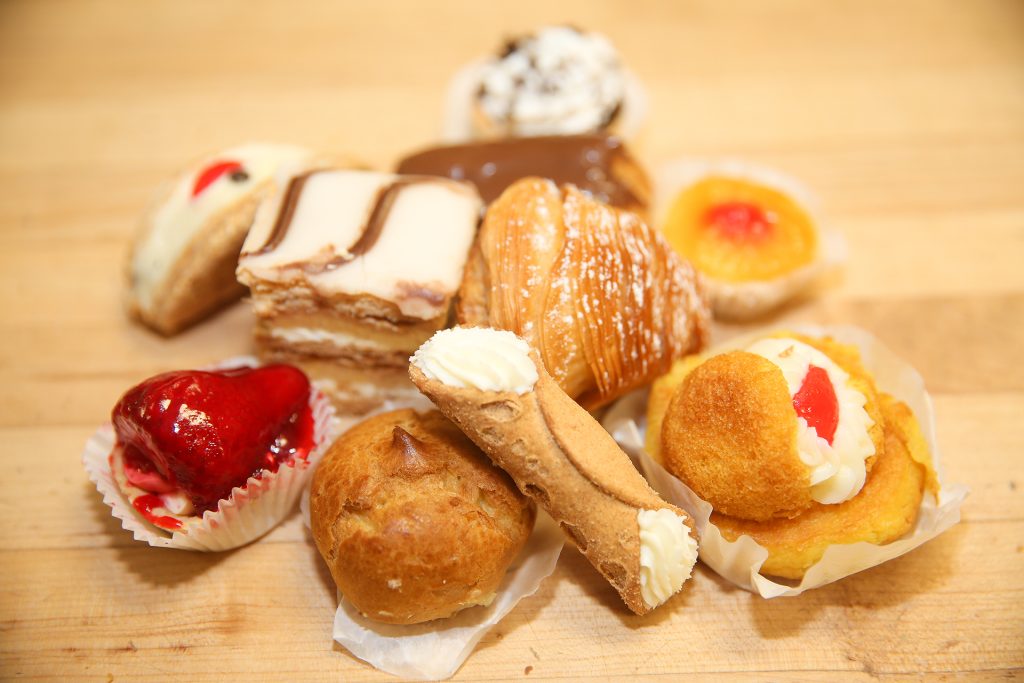Delectable pastry sweets are among the highlights of Italian cuisine, which is widely recognized for its rich culinary legacy. Italian pastry treats are renowned for their exquisite flavors, delicate textures, and centuries-old traditions, ranging from creamy tiramisu to crispy cannoli. We’ll go deeply into the world of Italian pastry sweets in this comprehensive guide, examining its history, components, cooking techniques, and cultural significance. Italian pastries are a delightful combination of rich flavors, delicate textures, and centuries-old traditions that captivate the senses.

The Tiramisu
Origins: The popular dessert tiramisu, which translates to “pick me up” in Italian, has its roots in the Veneto area of the country. Tiramisu’s actual beginnings are unknown; however, it is thought to have originated in the 1960s and has since become a mainstay of Italian cooking.
Ingredients: Layers of creamy mascarpone cheese, coffee-soaked ladyfingers, sugar, and cocoa powder are combined to make tiramisu. For additional flavor depth, some versions could involve adding spirits like rum or Marsala wine.
Preparation: First, prepare the tiramisu by dipping ladyfingers in a combination of brandy and espresso. Pour a creamy mascarpone mixture (mascarpone cheese, sugar, and egg yolks) over the soaked ladyfingers. After layering again, sprinkle more chocolate powder on top. Before serving, chill the tiramisu for a few hours to let the flavors combine.
Cannoli
Origins: Sicilian cannoli have their roots in the Arab conquest of Sicily around the ninth century. These crispy, tube-shaped shells are a popular delicacy in Italy and beyond and are filled with sweet ricotta cheese. They have become synonymous with Sicilian cuisine. Italian pastries like cannoli are cherished treats enjoyed by people of all ages, adding a touch of sweetness to festive gatherings and celebrations.
Ingredients: A crispy, fried pastry shell filled with a sweet ricotta cheese mixture is used to make cannoli. Ricotta cheese, sugar, vanilla essence, and occasionally candied fruit or chocolate chips are added to the filling for flavor and texture. Italian pastries like cannoli are cherished treats enjoyed by people of all ages, adding a touch of sweetness to festive gatherings and celebrations.
Cultural Significance: Cannoli are a staple of Sicilian cooking and are frequently consumed at holidays and festivities like Easter and Carnival. They are available in bakeries and cafes all across Italy and are a much-liked street food snack there as well. Italian pastries like cannoli are cherished treats enjoyed by people of all ages, adding a touch of sweetness to festive gatherings and celebrations.
Panna Cotta
Origins: The creamy delicacy known as panna cotta, which translates to “cooked cream” in Italian, has its roots in the Piedmont area of the country. Although its precise origins are unknown, panna cotta has been a mainstay of Italian cuisine for generations and has been relished throughout the country.
Preparation: The preparation of panna cotta is not too complicated. After warming the cream, sugar and gelatin are added to thicken the liquid. The mixture is poured into molds and cooled until set after the gelatin has dissolved. Italian pastries like panna cotta are cherished treats enjoyed by people of all ages, adding a touch of sweetness to festive gatherings and celebrations.
Cultural Significance: There are numerous ways to flavor panna cotta, making it a highly adaptable dish. Because of their delicate flavor and creamy texture, Italian pastries like panna cotta are frequently served as a light and refreshing dessert at the conclusion of a meal and are liked by people of all ages.
Read more about: Examining Dried Fruit: A Tasty Adventure
Zeppola
Origins: Southern Italy is the birthplace of zeppola, a typical Italian pastry akin to doughnuts. They are a staple of Italian cuisine and are usually consumed on March 19, the day of the annual Feast of Saint Joseph.
Components: Zeppola I used a basic dough consisting of flour, sugar, eggs, and water. After being deep-fried till golden brown and crispy, the dough is often filled with ricotta cheese or pastry cream and coated with powdered sugar. Italian pastries like zeppola are cherished treats enjoyed by people of all ages, adding a touch of sweetness to festive gatherings and celebrations.
Preparation: Zeppola preparation is not that difficult. After the dough is combined, spoonful’s of it are dipped into boiling oil and fried till crisp and golden brown. Before serving, the cooked zeppola is drained on paper towels and sprinkled with powdered sugar. Italian pastries like zeppola are cherished treats enjoyed by people of all ages, adding a touch of sweetness to festive gatherings and celebrations.
Cultural Significance: Zeppola is a common Italian street food snack that is eaten at fairs, festivals, and other special occasions. They are also a popular dessert in Italian-American neighborhoods, where they are frequently offered around Christmas. Italian pastries like zeppola are cherished treats enjoyed by people of all ages, adding a touch of sweetness to festive gatherings and celebrations.

Specialized FAQs
Where did Italian pastry treats come from?
Italian pastry sweets are derived from the food of ancient Rome and mediaeval Europe, with French, Spanish, and Arab culinary traditions also having an influence.
Are pastries from Italy hard to prepare at home?
While many Italian pastry dessert recipes are rather straightforward and can be prepared at home using basic ingredients and equipment, some may call for more sophisticated baking techniques.
Which prominent versions of Italian pastry treats are there?
Various fillings for filled cannoli, regional delicacies like Neapolitan sfogliatella, and varieties of tiramisu are popular variations of Italian pastry treats.
Can gluten be removed from Italian pastry desserts?
It is possible to make a lot of Italian pastry delicacies gluten-free by using substitute flour, like rice or almond flour, and modifying the recipe accordingly.
How should one savor desserts made with Italian pastries?
Fresh Italian pastry desserts are the best, and to bring out the flavors and elevate the dining experience, match them with a glass of sweet wine or a cup of espresso.
In summary
To sum up, Italian pastry desserts are evidence of the country’s extensive culinary tradition and love of decadent confections. Each dessert, such as the crispy cannoli shells and the creamy layers of tiramisu, delivers a distinctive combination of flavors and textures that entice the senses and take guests to the sun-drenched streets of Italy. Italian pastry sweets are sure to please any sweet craving and create a lasting impact, whether they are eaten as a special treat or as part of a traditional Italian meal. Italian pastries are a delightful combination of rich flavors, delicate textures, and centuries-old traditions that captivate the senses.








